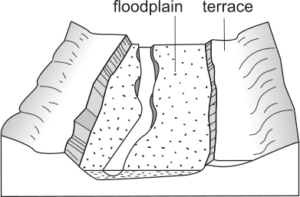Alluvial terrace (fill terrace)
Position: Floodplain
Form
Typically a relatively flat (planar), valley marginal feature that is perched above the contemporary channel and/or floodplain. These abandoned floodplains are no longer active. Generally separated from the contemporary floodplain by a steep slope called a terrace riser. Can be paired or unpaired. Often found as a flight of terraces. Terraces may be of great age (e.g. Tertiary terraces are not uncommon). Terraces often confine the contemporary channel, in a manner that is analogous to bedrock valley margins.
Process description
Initially formed by lateral and vertical accretion processes under prior flow conditions. Tectonic uplift, a change to base level, or shifts in sediment-load and discharge regime (linked to climate), prompt downcutting into valley floor deposits, abandoning the former floodplain. In many cases, a contemporary floodplain subsequently develops and becomes inset within these terraces. Unpaired terraces reflect lateral shift during incision, whereas paired terraces indicate rapid downcutting only.

